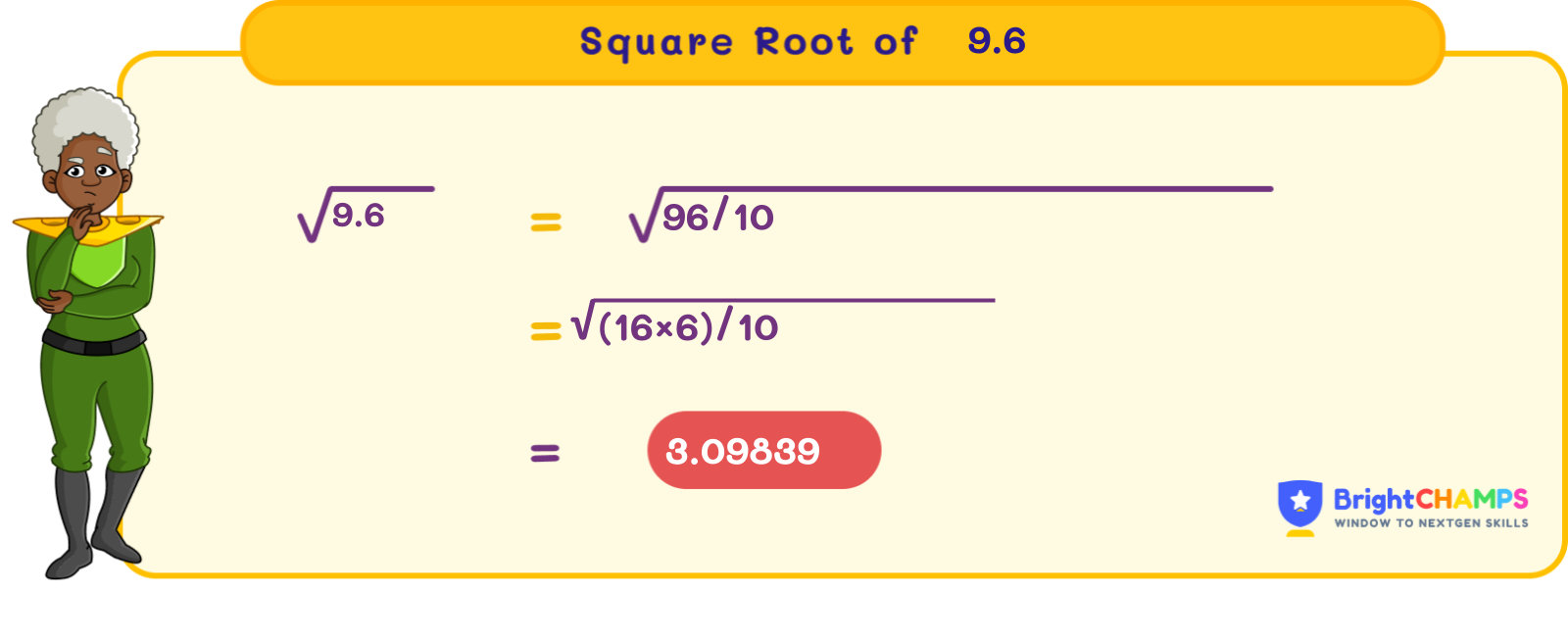![]() Table Of Contents
Table Of Contents

 100 Learners
100 LearnersLast updated on April 7th, 2025

Square Root of 9.6

If a number is multiplied by itself, the result is a square. The inverse operation of squaring is finding the square root. Square roots are used in various fields like physics, engineering, and finance. Here, we will discuss the square root of 9.6.
What is the Square Root of 9.6?
The square root is the inverse operation of squaring a number. 9.6 is not a perfect square. The square root of 9.6 can be expressed in both radical and exponential forms. In radical form, it is expressed as √9.6, whereas in exponential form, it is (9.6)^(1/2). √9.6 ≈ 3.098, which is an irrational number because it cannot be expressed in the form of p/q, where p and q are integers and q ≠ 0.
Finding the Square Root of 9.6
The prime factorization method is generally used for perfect squares. However, for non-perfect square numbers like 9.6, methods such as the long division method and approximation method are used. Let's explore these methods: -
- Long division method
- Approximation method
Square Root of 9.6 by Long Division Method
The long division method is used to find the square root of non-perfect squares. Here is how to find the square root of 9.6 using the long division method:
Step 1: Begin by setting up the number 9.6. Since it involves a decimal, consider 960 (by multiplying by 100 to eliminate the decimal temporarily).
Step 2: Find the largest number whose square is less than or equal to 9. In this case, it's 3 because 3^2 = 9.
Step 3: Subtract 9 from 9 to get 0 and bring down the next two digits (60).
Step 4: Double the divisor (3) to get 6, then determine the largest digit (n) such that 6n × n ≤ 60. The correct digit is 0 (since 60 is the nearest number divisible by 60), so the new divisor is 60.
Step 5: Subtract 60 from 60 to get 0, then bring down the next two digits (00) to continue the division.
Step 6: Continue this process, adding decimal places and zeroes as needed until the desired level of precision is reached.
The square root of 9.6 is approximately 3.098.
Square Root of 9.6 by Approximation Method
The approximation method is a simple way to find the square root of a non-perfect square. Here's how to find the square root of 9.6 using this method:
Step 1: Identify the perfect squares closest to 9.6. The smallest perfect square is 9, and the largest is 16. √9.6 lies between √9 (3) and √16 (4).
Step 2: Apply the interpolation formula: (Given number - smallest perfect square) / (Greater perfect square - smallest perfect square). For 9.6, (9.6 - 9) / (16 - 9) = 0.6 / 7 ≈ 0.086.
Step 3: Add this decimal to the smaller whole number: 3 + 0.086 ≈ 3.086.
Thus, the approximate square root of 9.6 is 3.098.

Common Mistakes and How to Avoid Them in the Square Root of 9.6

Square Root of 9.6 Examples

Problem 1
Can you help Max find the area of a square box if its side length is given as √9.6?

Explanation

Problem 2
A square-shaped building measuring 9.6 square feet is built; if each side is √9.6, what will be the square feet of half of the building?

Explanation

Problem 3
Calculate √9.6 × 5.

Explanation

Problem 4
What will be the square root of (4 + 5.6)?

Explanation

Problem 5
Find the perimeter of the rectangle if its length ‘l’ is √9.6 units and the width ‘w’ is 3 units.

Explanation


FAQ on Square Root of 9.6
1.What is √9.6 in its simplest form?
2.What are the factors of 9.6?
3.Calculate the square of 9.6.
4.Is 9.6 a prime number?
5.9.6 is divisible by?
Important Glossaries for the Square Root of 9.6
- Square root: The square root is the inverse operation of squaring a number. For example, if 3² = 9, then √9 = 3.
- Irrational number: An irrational number cannot be expressed as a fraction p/q, where p and q are integers, and q is not zero.
- Approximation: Approximating involves finding a value close to the true value, often using methods like interpolation or rounding.
- Decimal: A decimal is a number that includes a fractional part separated by a decimal point, such as 3.098.
- Prime factorization: Prime factorization is the process of expressing a number as a product of its prime factors.
Explore More algebra
 Previous to Square Root of 9.6
Previous to Square Root of 9.6


Jaskaran Singh Saluja
About the Author
Jaskaran Singh Saluja is a math wizard with nearly three years of experience as a math teacher. His expertise is in algebra, so he can make algebra classes interesting by turning tricky equations into simple puzzles.

Fun Fact
: He loves to play the quiz with kids through algebra to make kids love it.




